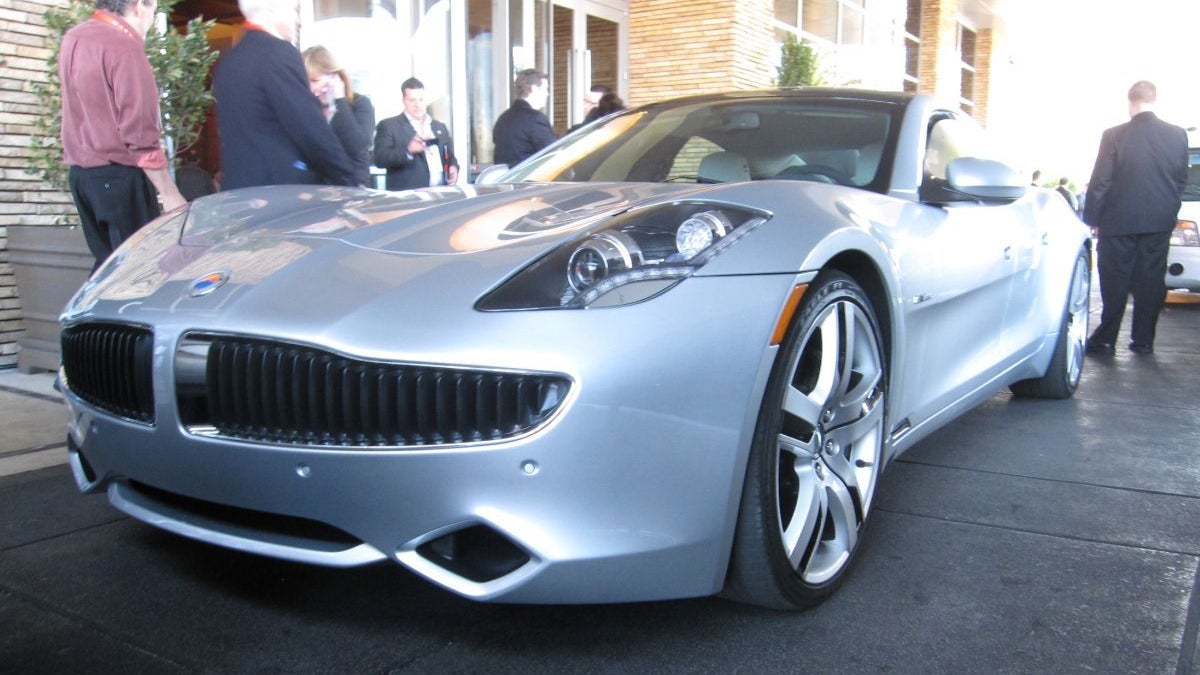Good Karma on the Vegas strip, by Fisker
Fisker brings its Karma-series hybrid to CES 2012 in Las Vegas, and CNET editor Wayne Cunningham takes it for a spin.

LAS VEGAS--The last thing I expected to do on my arrival in the city for CES 2012 was to take a quick drive in the Fisker Karma.
But as I walked out of the hotel near the Las Vegas Convention Center, there was the car, in all of its curvaceous, green glory, parked at the curb. A quick talk with the Fisker rep on hand, and soon I was in the driver's seat of this new-series hybrid car, models of which are just beginning to roll off the production line.
Looking around the cabin, I was surprised at the lack of leather, a typical lining for the innards of any high-end luxury car. Instead, surfaces were covered in a variety of thick, soft fabrics. This model was in Eco Chic trim, which keeps the animal carcasses away from passengers. Even the bits of wood trim in the car come from reclaimed sources, the remnants of a wildfire in Southern California and salvaged from the bottom of Lake Michigan, according to the Fisker rep accompanying me.
A 10.3-inch touch screen filled the center dashboard, and the instrument cluster was an LCD panel showing virtual gauges. The drive selector was like none I've ever seen before, four buttons in a crystalline structure like something from "Doctor Who." Blocks of clear plastic or glass, encasing fossilized magnolias, formed another exotic trim element.
Visteon, an automotive equipment supplier, played a big part in the cabin instrumentation and infotainment systems. It looked like Fisker raided the concept shelf at Visteon for the Karma's cabin. The touch screen uses haptic response, so you can feel when you touch a button. But it required harder pushes on that screen than you would have to use on a cell phone to make things happen, something that initially threw me. The infotainment system integrates TomTom software for navigation.
Pushing the start button kicked off a light display on the dashboard, but as is typical with a hybrid, there was no sound, no vibration from an engine kicking over. The Karma is an electrically driven car, with motors at each rear wheel. A big lithium ion battery pack runs down the center tunnel, which gives the Karma 50 miles of pure electric driving range, and also divides the rear seats, making it a four-seater. Under the hood, a gas engine, a turbocharged 2-liter four-cylinder sourced from GM, works as a generator, firing up when the batteries are depleted. With a full tank of gas, the engine brings the Karma's range up to 300 miles.
The car had seen some heavy use over the last few days, what with demos and the Fisker people actually driving it to Las Vegas from Los Angeles. As such, there wasn't much in the batteries. But that was okay, as I find it more interesting to test these types of cars under non-optimal conditions.
After pushing the D button, I found the accelerator very responsive, a precision control delivering the big electric push afforded by the Karma's 959 pound-feet of torque. The feeling of power is there, but the Karma isn't the fastest thing on the road. With a charged battery and Sport mode activated, it can get to 60 mph in 6.3 seconds, according to Fisker. But in its Stealth mode, the time increases to almost 8 seconds.
Still, the drivetrain delivers a feeling of power, a strong push uninterrupted by gear changes. The big front fenders, rising up to the driver's eye line, contribute in a purely psychosomatic manner.
With a straight stretch of road ahead, I put the pedal all the way down, and pushed the car up toward 60 mph. The gas engine, called on to supply electricity, audibly wound up, not with a vicious bark but a whirr in a minor key, which seemed to come from a distant valley. It is a very different feeling than being drawn forward by a big V-8. Different, but good.
The little 2-liter up front is mapped to the needs of the motors, gaining revs as more electricity is needed. I wonder what would happen with a bigger engine for a generator?
When I hit the brakes, regen kicked in, first with electric motor drag on the wheels, then with the friction brakes kicking in. The Karma made the sound hybrid owners the world over have become used to: the turbine whine decreasing as the car comes to a stop. One paddle on the steering wheel toggles the car between Sport and Stealth modes, the former getting its best potential with a full battery charge. The other paddle puts the car into Hill mode, which increases regeneration by letting the motors add more drag on the wheels. It was a palpable difference going from the two different Hill modes to freewheeling.
Getting into some turns, the Karma felt capable, its weight and big tires lending to grip. But I wouldn't call it nimble. Nothing with a curb weight of 5,300 pounds is going to feel nimble. But it turned responsively and with purpose. The conditions under which I was driving it didn't allow tire-sliding antics, so I can only extrapolate what it might be like at the edge. It didn't feel prone to body roll, but I imagine once it loses grip, it would lose it in a big way.
When Fisker finally had to come out with an EPA rating for the car, its 52 mpg equivalent and 20 mpg with the engine running disappointed many. But from my drive, I wouldn't look at the car as a Prius-beater. It is in a very different class, and certainly more fun to drive.
With its drivetrain and cabin electronics, the Karma certainly seemed like it belonged at the Consumer Electronics Show.

